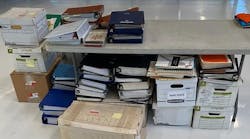From its humble beginnings with Bitcoin and Digital Currencies used by banks, investment companies and cryptocurrency dealers; blockchain is rapidly becoming a reality in many industries, which should include aviation.
Thanks to the independent verification processes that take place by members on a blockchain network, blockchain is impervious to hackers who can only reach a single point in the chain, and still not affect the entire network. This, of course, offers a tremendous level of security. And this is where aviation can really benefit.
There are two easily discernible ways the aircraft maintenance industry could utilize blockchain:
- With replacement parts or loaner components installed on an aircraft.
- In the aircraft’s maintenance planning process.
Parts and Loaner Components
In addition to the 8130 Airworthiness Certificate required to accompany a part, imagine an A&P technician being able to see the complete on/off cycle and maintenance/repair history of a part before installing this part on the aircraft? The operator of the aircraft receiving the part would become both knowledgeable of the history of the part, and have a much better understanding of why the part had been replaced by other operators on previous aircraft even to the point of having access to information of the repair accomplished by the vendor issuing the 8130.
Consider the following scenario: An Engine Start Valve is removed from N345 because it won't open to start the aircraft’s engine when it’s sitting at high-altitude airports. The Engine Start Valve is sent back to the manufacturer’s repair facility who "Bench Tests" the Valve but can't find anything wrong with it. The repair facility then returns the valve to service as NO FAULT FOUND. Another operator orders a Start Valve to put on their plane N678, so the repair facility sends them this valve ... now Returned to Service and sitting on the shelf ready for its next mission.
The aircraft operates without issue, until one day it attempts a start in Mexico City. And guess what? THE ENGINE START VALVE DOESN'T OPEN.
I know many A&P technicians that will tell you that this type of thing happens often in business aviation. But if the valve had been a part of a Block Chain of history hosted by the OEM or Repair facility, the maintenance people for N678 would have been able to see that the part had been removed from N345 due to a "will not start Engine at high altitude airport" issue. This would have alerted them to a potential problem that could become a serious issue, and to be prepared. At the very least, the operator might not have been caught completely unaware if the "no start" issue happened to them. Maybe they might have even decided to carry an extra valve "just-in-case" and wouldn't be in such as awkward position when the Start Valve Doesn’t Open issue surfaced during an otherwise routine trip.
The term for-warned is for-armed applies here. And being forewarned could save time, money, and potentially a busted flight. Because we would have more knowledge and information available to us through block chain that isn’t available to us today.
The Aircraft’s Maintenance Planning Process
Managing Maintenance Tracking Data: In another scenario, an operator inputs an aircraft into a local MRO for a maintenance event. Blockchain could be used to sync each task completed on the aircraft with the MRO workorder and the associated maintenance tracking company’s data. No longer would maintenance tracking data be distinct and sometimes different than from the logbook data completed by the maintenance provider or by flight department personnel.
Using with an Electronic Logbook: Using an electronic logbook could even further aid in the discovery and troubleshooting of the parts installed on an aircraft. A logbook would become not only a record of the history of maintenance performed on the aircraft but would also act as a data collection point for this information. For example: a parts blockchain combined with an electronic logbook would allow a person to "click" on the part recorded as installed on the aircraft to access its’ block chain. The information they now have access to via the block chain could potentially give them great insight into a problem they have just encountered on the aircraft, making the troubleshooting of the problem faster, and the resolution potentially much easier than starting from scratch without this information.
The Bottom Line
Digital documents and Electronic Record Keeping are fantastic technologies that business aviation can employ to improve the way we fly and manage aircraft. Block chain should be implemented on all aircraft parts and loaner equipment, at MROs and Maintenance Tracking companies, and combined with electronic logbooks will give us the current and accurate information we need to operate the sophisticated aircraft we fly.
We need to start taking advantage of the numerous benefits that the digital world offers to us. Block Chain is a step in the right direction.
Larry Hinebaugh is currently the executive director of a non-profit company called The Foundation for Business Aircraft Records Excellence. Hinebaugh was instrumental in creating this company after seeing so many aircraft operators inconvenienced, and aircraft owners financially harmed, by our industry’s poor logbook practices. A 40-year veteran of the business aviation Industry, Hinebaugh started his career as an A&P technician in a small jet maintenance shop in California and has since worked as a field service representative for Gulfstream Aerospace, director of maintenance for several corporations operating large business aircraft, and president of Aviation Consulting Group providing maintenance and completion representation to companies operating aircraft from Cessna’s to Boeing’s; before accepting his position with Business Aircraft Records (BAR).





